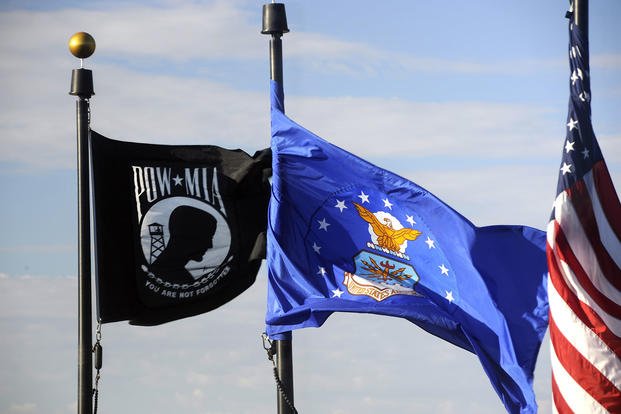You Are Not Forgotten -- that's the central phrase behind the POW/MIA remembrance movement that honors America's prisoners of war, those who are still missing in action and their families.
Many of our service members suffered as prisoners of war during several decades of varying conflicts. While some of them made it home, tens of thousands more never did.
Here are four things to know about how this important movement got started, what it means and how you can help recognize it.
POW/MIA Recognition Day
POW/MIA Recognition Day is commemorated on the third Friday of every September, a date that's not associated with any particular war. In 1979, Congress and the president passed resolutions making it official after the families of the more than 2,500 Vietnam War POW/MIAs pushed for full accountability.
During the first POW/MIA Recognition Day commemoration, a ceremony was held at the National Cathedral in Washington, D.C., while the 1st Tactical Squadron from Langley Air Force Base in Virginia flew the missing man formation. Most ceremonies since then have been held at the Pentagon, and many smaller observances have cropped up across the nation and around the world on military installations.
Related: A Missing ID Card Spent 50 Years in Vietnam. Now It's Coming Home
The point of POW/MIA Recognition Day is to ensure that American remembers to stand behind those who serve and to make sure we do everything we can to account for those who have never returned.
POW/MIA Numbers
In order to comprehend the importance of this movement, all you need to do is look at the sheer number of Americans who have been listed as POW/MIAs.
American POW Numbers
According to a Congressional Research Service report on POWs:
- 130,201 World War II service members were imprisoned; 14,072 them died.
- 7,140 Korean War service members were imprisoned; 2,701 of them died.
- 725 Vietnam War service members were imprisoned; 64 of them died.
- 37 service members were imprisoned during conflicts since 1991, including both Gulf wars; none is still in captivity
American MIA Numbers
According to the Defense POW/MIA Accounting Agency, 83,114 Americans who fought in those wars are still missing, including:
- 73,515 from World War II (an approximate number due to limited or conflicting data)
- 7,841 from the Korean War
- 1,626 from Vietnam
- 126 from the Cold War
- 6 from conflicts since 1991
The DPAA said about 75% of those missing Americans are somewhere in the Asia-Pacific. More than 41,000 have been presumed lost at sea.
Efforts to find those men, identify them and bring them home are constant. For example, the DPAA said that in the past year, it has accounted for 41 men missing during the Korean War: 10 had been previously buried as unknowns, 26 were from remains turned over by North Korea in the 1990s, one was from a recovery operation, and four were combinations of remains and recovery operations.
The POW/MIA Flag
The traditional POW/MIA flag that's well-known across America was actually created many years before the remembrance day became official.
In 1971, Mary Hoff contacted a flag company near her home to see whether a flag reminding people of POWs and the missing could be made. She was one of the many waiting to see whether her husband, Navy Lt. Cmdr. Michael Hoff, would ever return home after his plane had been shot down over Laos.
World War II pilot Newt Heisley designed the now-famous flag, which was made in black and white to represent the sorrow, anxiety and hope symbolized by the image of the gaunt man featured on it.
For every POW/MIA Recognition Day since 1982, the flag has flown just below the stars and stripes at the White House – the only other flag to ever do so. In 1998, Congress ordered it to also be displayed on Armed Forces Day, Memorial Day, Flag Day, Independence Day and Veterans Day.
Bracelets Help Continue the Support
While the POW/MIA flag reminds us to never forget our prisoners of war and missing in action, bracelets also became a popular personal form of remembrance in the 1970s. They're still worn and purchased by families and veterans, who are also wearing bracelets for those who were killed in action in more recent wars.
If you don't feel the need to buy a flag or bracelet, it's still important to remember the extreme sacrifices of our POW/MIAs and America's pact to them: That we will take care of them, and no matter how much time has passed, they will make it back home.
Stay on Top of Your Veteran Benefits
Military benefits are always changing. Keep up with everything from pay to health care by signing up for a free Military.com membership, which will send all the latest benefits straight to your inbox while giving you access to up-to-date pay charts and more.















